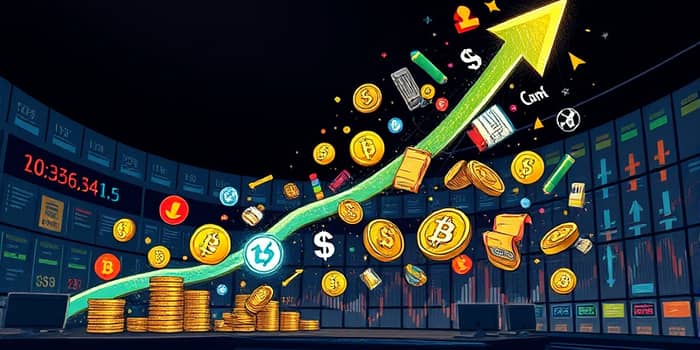Exchange-traded funds, or ETFs, have revolutionized modern investing by combining diversified basket of global assets with the simplicity of stock-like trading. Whether you are a seasoned investor or at the beginning of your journey, ETFs offer unprecedented flexibility to build a resilient portfolio aligned with your goals.
What Is an ETF?
An ETF is an investment fund that trades on exchanges, holding a basket of assets such as stocks, bonds, or commodities. Investors can gain exposure to hundreds or even thousands of securities through a single ticker symbol.
Think of an ETF as a team of assets working together to mirror the performance of a target index—be it the S&P 500, Nasdaq, or a more specialized theme like clean energy or emerging markets. Some ETFs track broad market benchmarks, while others focus on specific sectors, regions, or commodities.
Popularity & Growth Statistics
The ETF industry has witnessed explosive growth in recent years. As of the end of 2023, global ETF assets surpassed $8 trillion in assets globally, reflecting booming investor demand for low-cost, transparent products.
In key markets, ETF assets have grown at compound annual growth rates exceeding 100% over the past five years. Vanguard reports that an impressive 84% of its ETFs outperformed peer-group averages over the past decade, underscoring the power of passive, index-based strategies.
Key Benefits of ETFs
- Diversification across hundreds or thousands of securities
- Daily transparency of holdings
- Intraday trading flexibility
- Low expense ratios and cost efficiency
- Enhanced tax efficiency
- Access to global and niche markets
One of the most compelling advantages of ETFs is built-in diversification across asset classes, reducing the company-specific risk inherent in individual stock ownership. By holding a single ETF, investors benefit from exposure to multiple industries, geographies, or bond maturities.
Transparency is another hallmark feature. ETFs disclose their underlying holdings daily, providing daily disclosure of holdings so investors always know exactly what they own. This level of openness contrasts with mutual funds, which often report holdings only quarterly.
ETFs also excel in accessibility and flexibility. Investors can execute a buy or sell order at any point during market hours, capturing real-time pricing. This intraday trading with real-time pricing allows for swift reactions to market news or portfolio rebalancing needs.
When it comes to cost, ETFs are industry leaders. The average ETF expense ratio stands at around 0.50%, often half the cost of comparable mutual funds. Vanguard’s suite of ETFs boasts an average fee of just 0.05% versus the industry average of 0.22%, delivering often half the cost of traditional vehicles.
Tax efficiency rounds out the benefits. Thanks to an in-kind creation and redemption process, ETFs tend to distribute fewer capital gains. In 2024, 99% of Vanguard ETFs reported no capital gains distributions, making them more tax-efficient than mutual funds for many investors.
Comparing ETFs, Mutual Funds, and Stocks
Types and Strategies of ETFs
- Core Market ETFs: broad exposure to domestic or global markets
- Sector & Thematic ETFs: targeted to industries like technology or trends such as ESG
- Commodity ETFs: track gold, oil, or agricultural products
- Active vs. Passive ETFs: passive index trackers vs. actively managed funds
Passive ETFs aim to replicate index returns, with tracking error serving as a key performance metric. Active ETFs, while charging higher fees, strive to outperform benchmarks through professional management and tactical asset allocation.
Risks Associated With ETFs
Despite their many advantages, ETFs carry certain risks. Market risk remains paramount: the value of an ETF fluctuates with the underlying assets. Investors should remain aware that no investment is entirely immune to volatility.
Tracking error is another consideration. Although passive ETFs seek benchmark fidelity, small deviations can occur, leading to slight under- or overperformance versus the index.
Liquidity risk may impact niche or very new ETFs, resulting in wider bid-ask spreads. Conducting due diligence on trading volumes and premium/discount behavior can help mitigate this concern.
Expert Endorsements & Practical Advice
Legendary investor Warren Buffett has long endorsed low-cost index funds, and by extension, ETFs that track major benchmarks. He has noted that more than 90% of large-cap US companies failed to outperform the S&P 500 over extended periods, illustrating the efficacy of broad market exposure.
Practical advice for investors:
- Define your investment goals and risk tolerance before selecting ETFs.
- Diversify across asset classes to balance growth and stability.
- Compare expense ratios and tracking error metrics when choosing products.
How to Invest in ETFs
Investing in ETFs is as straightforward as trading stocks. You need a brokerage account—many offer commission-free ETF trading—and you can place market or limit orders during normal trading hours.
Steps to get started:
- Open and fund a brokerage account with a reputable provider.
- Research ETFs that align with your target asset allocation.
- Use limit orders to manage execution price and control transaction costs.
- Monitor holdings and rebalance periodically to maintain portfolio alignment.
Future Outlook
The ETF industry shows no signs of slowing down. Investors continue to gravitate toward cost-efficient investment vehicle solutions that offer transparency and diversification. Product innovation remains robust, with new funds targeting emerging technologies, sustainability themes, and specialized niches.
As global markets evolve, ETFs are poised to deliver even greater access and customization. From digital assets to frontier markets, the next generation of ETFs will empower investors to capture opportunities across the financial landscape with simplicity and precision.
References
- https://www.blackrock.com/americas-offshore/en/education/etf/explaining-etfs
- https://www.aberdeeninvestments.com/en-lu/institutional/investment-solutions/thematic-investing/key-benefits-of-etfs
- https://www.fidelity.com/learning-center/smart-money/benefits-of-etfs
- https://investor.vanguard.com/investor-resources-education/etfs/etf-vs-mutual-fund
- https://investor.vanguard.com/investment-products/etfs
- https://www.miraeassetmf.co.in/knowledge-center/exchange-traded-funds
- https://www.nerdwallet.com/article/investing/what-is-an-etf
- https://www.merrilledge.com/article/things-you-should-know-about-etfs










